If you’re all-in on WordPress and need high-performance hosting that scales smoothly under serious traffic—or you’re already serving tens of thousands of monthly visitors—then WP Engine belongs at the top of your shortlist.
Built from the ground up for WordPress-only hosting, WP Engine focuses relentlessly on speed, reliability, and security—and it shows in day-to-day use.
It doesn’t just promise performance; it delivers with a WordPress-tuned stack (EverCache®), a Cloudflare-powered global CDN, automated updates, and smart security hardening that keeps your site fast and safe.
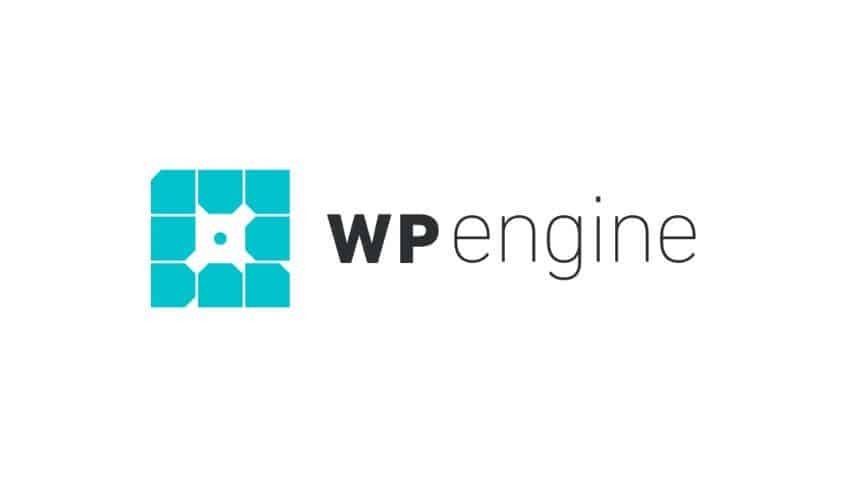
How WP Engine Stacks Up to Other Web Hosts
Because WP Engine is laser-focused on WordPress, it’s not as hand-holding as all-purpose, beginner-centric hosts like DreamHost or SiteGround. If you’re comfortable working in WordPress and want maximum speed, security, and workflow tools, WP Engine is a top contender. If you’d rather have a drag-and-drop builder and bundled extras, a more beginner-friendly host may feel easier.
Starting a first site, on a tight budget, or still learning the basics? Begin with a simpler provider from our guide to the best web hosting solutions, then upgrade when traffic and needs grow.
Where WP Engine Stands Out
True to its vision, WP Engine keeps the experience streamlined and pro-ready, emphasizing speed, stability, developer tools, and thoughtful safeguards that matter when your site is mission-critical.
Ease of Use (the good)
Signup is straightforward: pick a plan, add your billing details, and you’re nearly there. You can choose a region for your first site during setup (or have WP Engine place you near your audience automatically), and you can request a different region later if compliance or latency requires it.
Being able to choose a data center region that’s close to your primary audience helps reduce latency and improve real-world load times—useful whether your visitors are concentrated in North America, Europe, or APAC.
Rather than a handful of options, WP Engine offers multiple global regions on modern cloud infrastructure (shared plans default to Google Cloud; other infrastructure is available on higher tiers). That flexibility is a plus for international or compliance-sensitive sites.
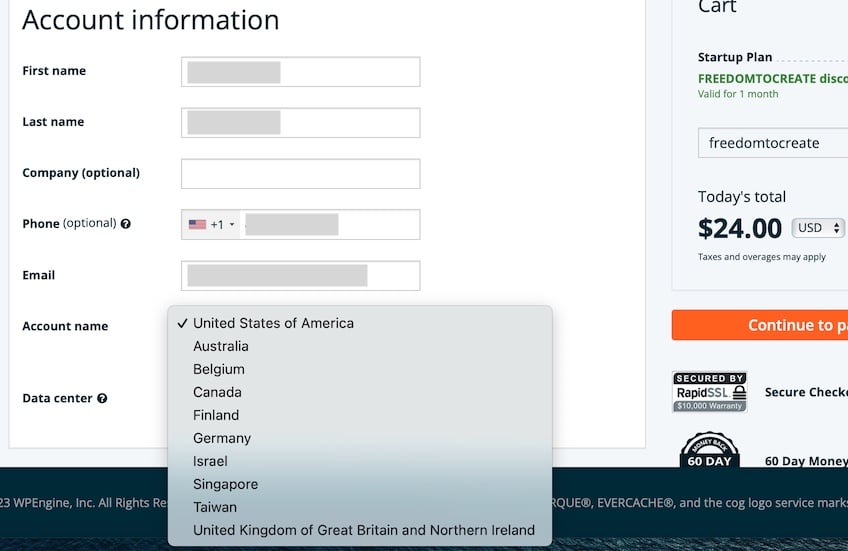
For ecommerce or membership sites with regional audiences, placing your site in-region can lift conversions by shaving precious milliseconds off every request.
Need extras? WP Engine offers powerful add-ons like Smart Plugin Manager (safe automated updates with visual testing), Global Edge Security (managed WAF and advanced DDoS), Site Monitoring, Application Performance, and more. These can raise your bill, but they’re worth it if uptime and speed are tied to revenue.
They also include a default temporary subdomain for every environment, so you can build and test before pointing your custom domain. You’ll add your live domain later in the User Portal when you’re ready to go live.
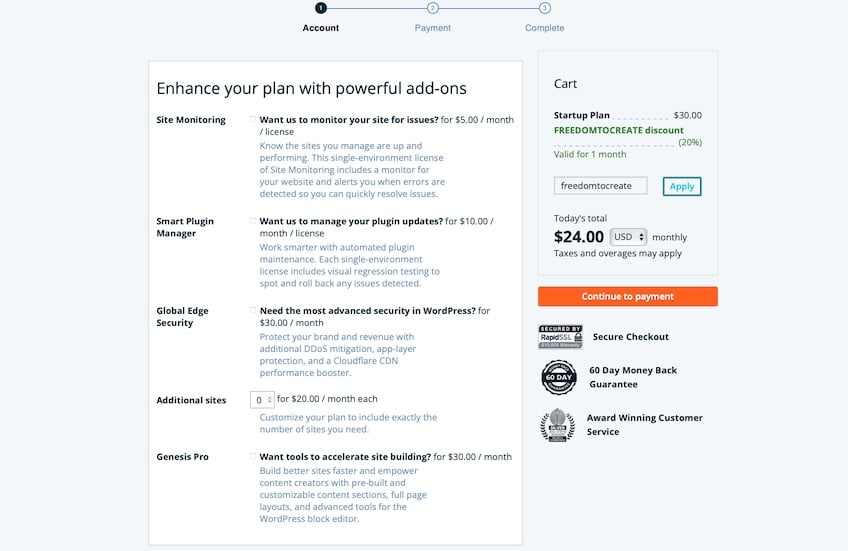
One caveat: WP Engine currently accepts credit/debit cards for billing (no PayPal). That won’t matter to most businesses, but it’s good to know up front.
After signup you’ll confirm your account via email, then log in and finish setup. The post-purchase emails include clear next steps and links to everything you need.
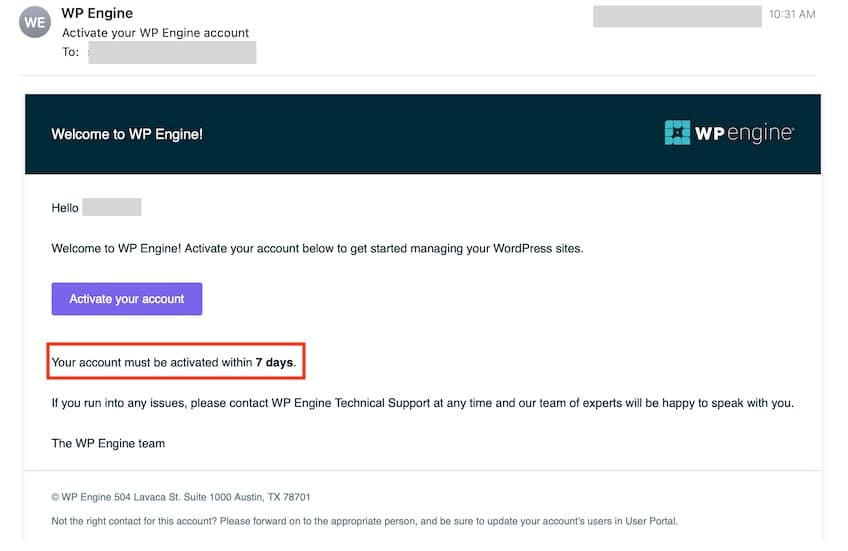
In many cases you’ll also be prompted to schedule an onboarding session, which is handy if you want a guided walkthrough or have migration questions.
Inside the account, the Get Started links surface your key actions right away—launch a site, migrate, point DNS, add SSL—so you’re not hunting through menus.
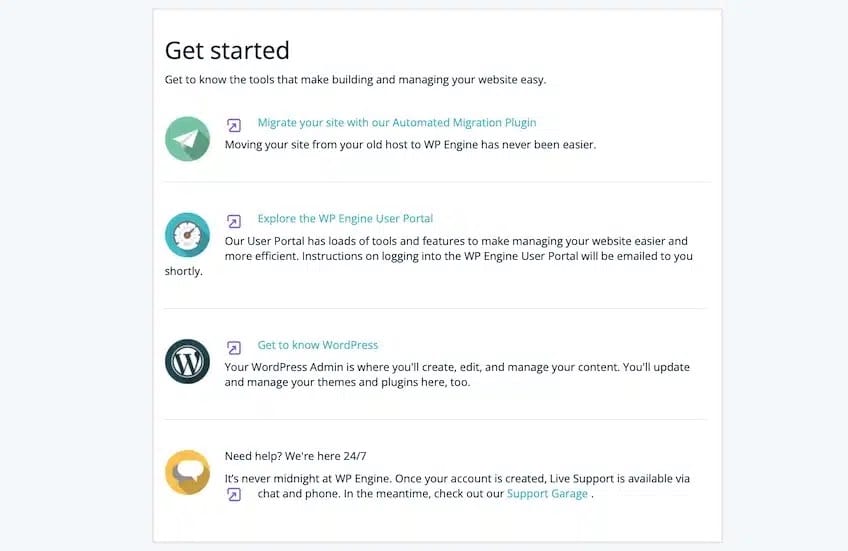
You’ll also get a welcome email linking to the User Portal, which is where you’ll spend most of your time managing sites, users, billing, and advanced settings.
The User Portal is a modern, clean alternative to cPanel. Navigation is obvious, environments are well-labeled (dev/stage/prod), and technical settings are a click away without clutter.
It’s one of the most intuitive managed-WordPress dashboards we’ve tested—fast for power users without overwhelming newer admins.
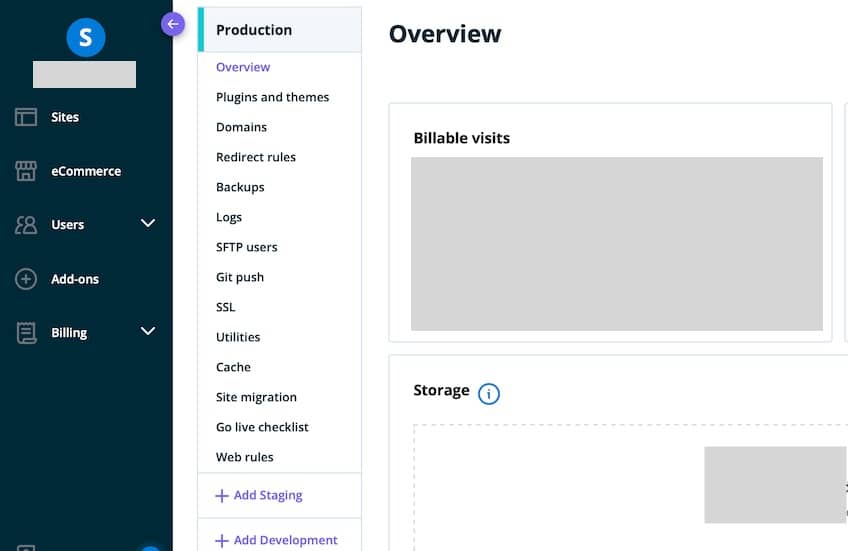
An optional in-portal walkthrough is available any time, so you can learn as you go and revisit steps later.
Adding a site is simple. You can create a fresh WordPress install or migrate an existing site with WP Engine’s automated migration plugin—no command line required. It’s not as wizard-heavy as some budget hosts, but it’s still a smooth start.
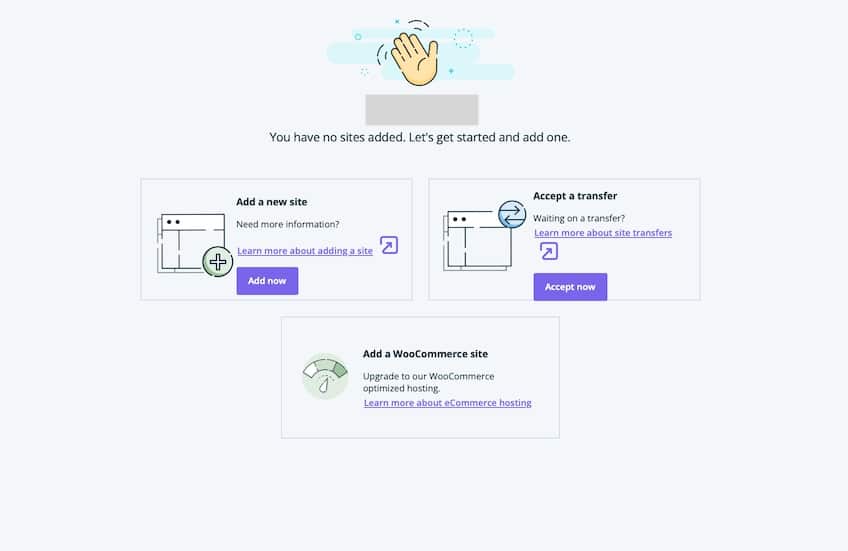
Once your site is live, the site-specific sidebar makes everyday tasks fast, including:
- Plugins and themes
- Domains
- Redirect rules
- Backups
- Logs
- SFTP users
- Git push
- SSL
- Utilities
- Cache
- Site migration
- Go live checklist
- Web rules
The built-in Go Live Checklist is excellent—DNS, SSL, redirects, and search-and-replace steps are all tracked so launches don’t miss critical details.
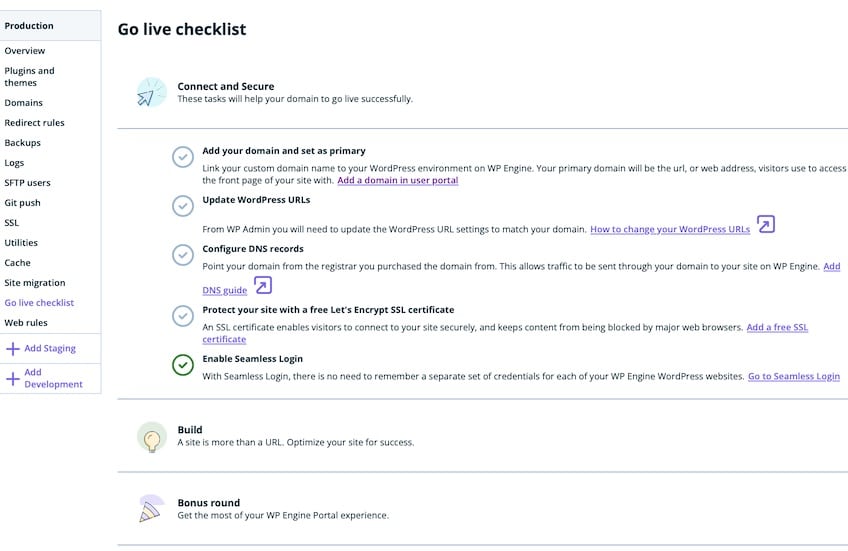
WP Engine’s platform is tuned for WordPress speed and security: EverCache®, a Cloudflare CDN, proactive threat mitigation, automatic WordPress/PHP updates, daily backups, and optional advanced security add-ons. Many sites see an average 40%+ page-speed boost after migrating, which is the kind of improvement users—and search engines—notice.
Bottom line: with WP Engine you’re getting a hardened, high-performance environment made for serious WordPress workloads.
Scalability
Whether you’re launching a new site or growing an established store, WP Engine scales cleanly. Plans step up in visits, storage, bandwidth, and support so you can expand without re-platforming.
The Startup plan is designed for up to 25,000 visits/month. From there, Professional and Growth increase capacity to 75,000 and 100,000 visits, and Scale handles up to 400,000 visits. Enterprise options go beyond that with custom resources and SLAs.
Storage and bandwidth grow as you do: entry plans include 10 GB storage / 75 GB bandwidth, mid-tier plans move to 15–20 GB / 150–240 GB, and Scale provides 50 GB / 550 GB. Dedicated and enterprise tiers exceed those figures.
Upgrades are quick from the User Portal (Billing > Modify Plan). Changes take effect fast, with no manual migrations required.
There’s also WooCommerce-optimized hosting with performance tuning and caching tailored for dynamic carts and checkouts—ideal when speed directly impacts revenue.
If growth is part of your plan, WP Engine is built to keep pace without drama.
Where WP Engine Could Improve
WP Engine checks many boxes but isn’t perfect. A few limitations are worth noting before you commit.
Ease of Use (the not so good)
There’s no bundled site builder. You’ll build inside WordPress (Gutenberg) or use a third-party page builder like Elementor. If you want an all-in-one, drag-and-drop experience out of the box, a different host will feel friendlier.
If you’re already comfortable with WordPress, this won’t slow you down. Beginners may face a learning curve during the first setup.
Some backend tools assume a moderate technical baseline. For example, redirect rules and web-rules are powerful but assume you know what you’re changing and why—great for control, not so great for first-timers.
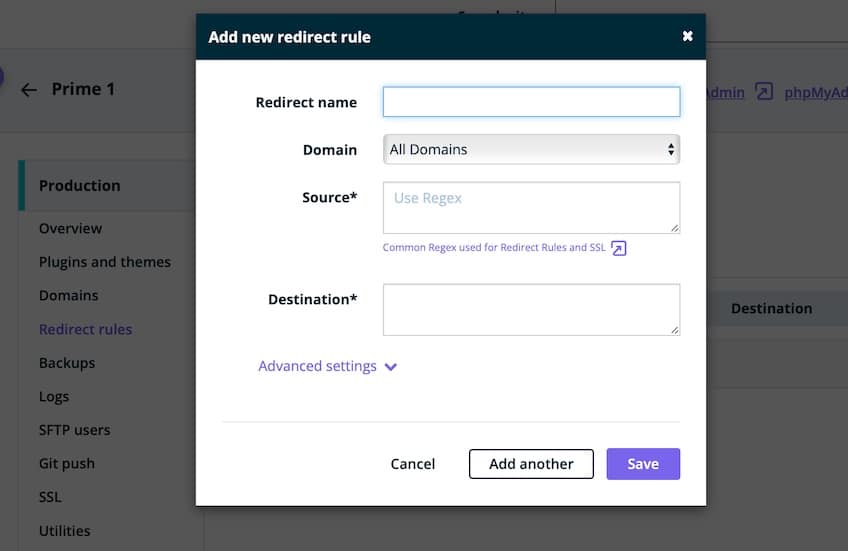
That “DIY with good tooling” philosophy appears elsewhere, too. If you’re unfamiliar with staging, version control, or file structure, expect a short ramp-up period.
Site migration is typically a self-service flow using WP Engine’s migration plugin with support on standby. It’s reliable, but if you want fully managed, white-glove migrations, those are tied to premium onboarding or enterprise arrangements rather than included on entry plans.
We’d love to see a more guided, beginner-friendly migration option on lower tiers.
Customer Support
Support quality is strong, but access varies by plan. The Startup plan includes live chat, while phone support is available on higher tiers. If you prefer to talk through urgent issues, budget for Professional or above.
Response speed can depend on queue volume. During peak times you may be asked to leave a message in chat; that’s not ideal if you’re in the middle of a launch or a sale.
Even when chat is online, waits can stretch before you reach a human (you’ll also interact with a bot first). Many premium hosts include faster access by default; here you’ll pay more for the same.
Email/ticket support is also available. The support portal keeps a log of open and closed tickets, including transcripts of chat sessions, so teams can track issues across shifts.
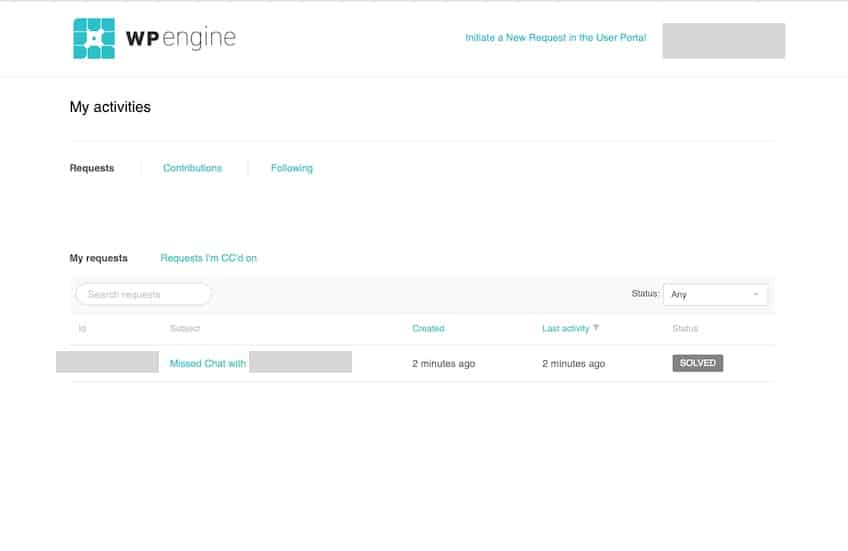
Overall, support is solid—just remember that phone access is a plan feature, not a given.
Plans & Pricing
WP Engine offers four core managed WordPress plans with essentials built in: free SSL, Cloudflare CDN, daily and on-demand backups, automatic WordPress/PHP updates, dev/stage/prod environments, EverCache®, and 10 premium StudioPress themes. WooCommerce-specific plans are available if you sell online.
- Startup: From $25/month – 1 website, 10 GB storage, 75 GB bandwidth
- Professional: From $50/month – 3 websites, 15 GB storage, 150 GB bandwidth
- Growth: From $96/month – 10 websites, 20 GB storage, 240 GB bandwidth
- Scale: From $242/month – 30 websites, 50 GB storage, 550 GB bandwidth
- Custom: Enterprise-level plans with tailored capacity, security, and SLAs
WP Engine sits on the premium end of the pricing spectrum, but you’re paying for a faster stack, better tooling, and a security model designed for production WordPress.
Most sites can start on Startup and move up as visits, storage, or bandwidth grow. Upgrades are painless in the User Portal.
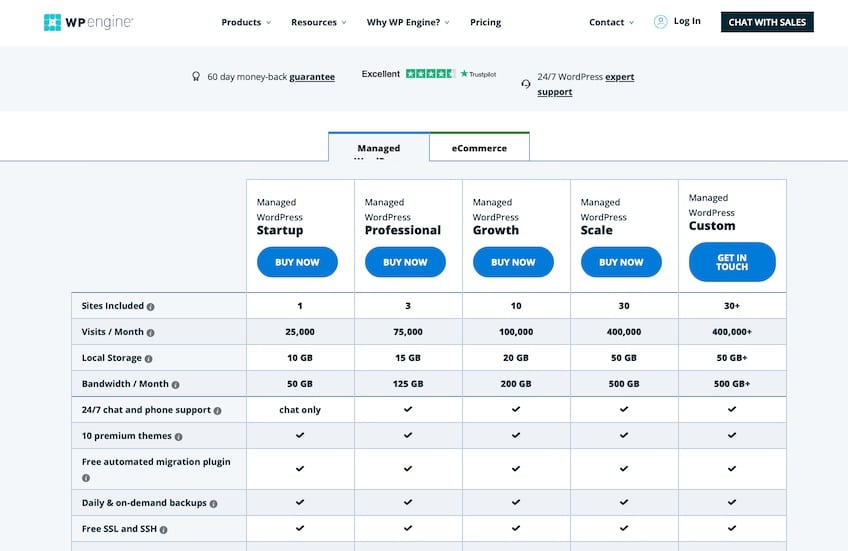
You can pay monthly or annually. Annual billing typically includes first-year promotional pricing; renewals bill at standard rates. Monthly billing is more flexible but costs more over time.
Plans include visit-based overage fees if you exceed your monthly limits (disclosed during checkout). Factor this in if you expect spikes, or step up a tier ahead of a campaign.
WP Engine keeps hosting focused by not bundling domains or email. That means more control—and no surprise lock-ins—but you’ll handle them separately.
- Domain registration: Buy from any registrar you prefer
- Domain privacy: Optional at your registrar
- Domain renewal: Managed at your registrar at their renewal rate
- Email hosting: Use a third-party provider like Google Workspace or Zoho Mail
If you need help picking a name, see our guide on how to buy a domain name.
There’s a 60-day money-back guarantee on new Startup, Professional, Growth, and Scale plans. Request your refund during cancellation in the User Portal; add-ons and premium/custom plans aren’t included.
In practice, cancellations and refunds are typically straightforward. Your timeline may vary, but it’s generally a low-friction process.
WP Engine is a world-class managed WordPress host. If you’re budget-conscious or building your first site, you’ll likely be happier starting with an easier, cheaper option from our top web hosting picks—and graduating to WP Engine when performance and scale become non-negotiable.
